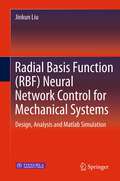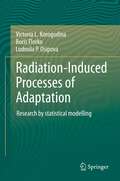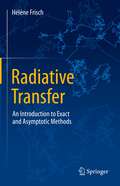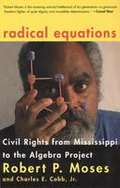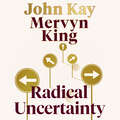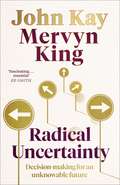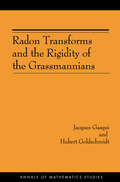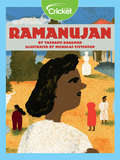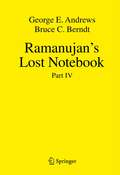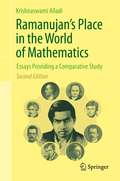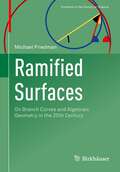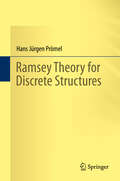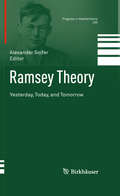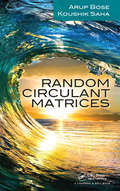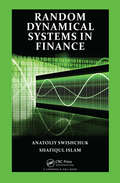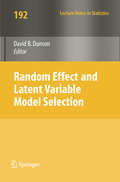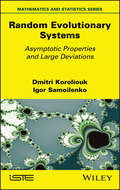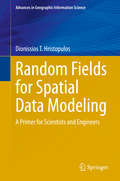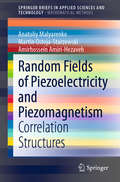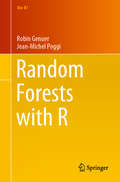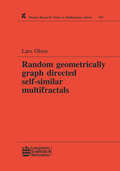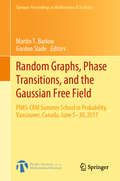- Table View
- List View
Radial Basis Function (RBF) Neural Network Control for Mechanical Systems
by Jinkun LiuRadial Basis Function (RBF) Neural Network Control for Mechanical Systems is motivated by the need for systematic design approaches to stable adaptive control system design using neural network approximation-based techniques. The main objectives of the book are to introduce the concrete design methods and MATLAB simulation of stable adaptive RBF neural control strategies. In this book, a broad range of implementable neural network control design methods for mechanical systems are presented, such as robot manipulators, inverted pendulums, single link flexible joint robots, motors, etc. Advanced neural network controller design methods and their stability analysis are explored. The book provides readers with the fundamentals of neural network control system design. This book is intended for the researchers in the fields of neural adaptive control, mechanical systems, Matlab simulation, engineering design, robotics and automation. Jinkun Liu is a professor at Beijing University of Aeronautics and Astronautics.
Radiation-Induced Processes of Adaptation: Research by statistical modelling
by Victoria L. Korogodina Ludmila P. Osipova Boris FlorkoIn recent decades radiobiologists' efforts have been directed at identifying the mechanisms of radiation effects; the general mechanisms have since been studied extensively. This book describes and analyzes radiation-induced adaptation as processes produced in cells, tissues, and populations. This viewpoint helps to understand the nature and factors of induced processes, to determine the characteristics of observed radiation effects and their limitations. The investigations presented here were founded on proper lab experiments, ecological studies of plant population growth near an operating nuclear power plant and a thorough epidemiological examination of human populations living in territories polluted fifty years ago, as well as on relevant published data. This research demonstrates the radiation-induced adaptation processes that continue even when the radiation itself is no longer at a critical background level. The investigations utilized the method of statistical modeling on the basis of distributions on the number of abnormalities. This method allows us to investigate the processes induced by low-dose factors when accompanied by Darwinian selection in different systems; the distribution parameters can then be used to study the characteristics of adaptation processes and system resistance. The consequences of background-level radiation continue to provoke debate, and the mathematical bases of the adaptation model are shown, while due consideration is paid to the components of adaptation: instability, selection, and proliferation. The book will be especially useful to specialists in radiation pollution, ecology, epidemiology, and radiology for studies of radiation-induced processes; the method presented here can also be adapted to investigate low-dose effects in other fields. In addition, the book presents a number of reviews in the fields of radiation biology, including pioneering investigations in Russia which were previously unavailable to Western scientists.
Radiative Transfer: An Introduction to Exact and Asymptotic Methods
by Hélène FrischThis book discusses analytic and asymptotic methods relevant to radiative transfer in dilute media, such as stellar and planetary atmospheres. Several methods, providing exact expressions for the radiation field in a semi-infinite atmosphere, are described in detail and applied to unpolarized and polarized continuous spectra and spectral lines. Among these methods, the Wiener–Hopf method, introduced in 1931 for a stellar atmospheric problem, is used today in fields such as solid mechanics, diffraction theory, or mathematical finance. Asymptotic analyses are carried out on unpolarized and polarized radiative transfer equations and on a discrete time random walk. Applicable when photons undergo a large number of scatterings, they provide criteria to distinguish between large-scale diffusive and non-diffusive behaviors, typical scales of variation of the radiation field, such as the thermalization length, and specific descriptions for regions close and far from boundaries. Its well organized synthetic view of exact and asymptotic methods of radiative transfer makes this book a valuable resource for both graduate students and professional scientists in astrophysics and beyond.
Radical Equations: Civil Rights from Mississippi to the Algebra Project
by Charles E. Cobb Robert MosesAt a time when popular solutions to the educational plight of poor children of color are imposed from the outside—national standards, high-stakes tests, charismatic individual saviors—the acclaimed Algebra Project and its founder, Robert Moses, offer a vision of school reform based in the power of communities. Begun in 1982, the Algebra Project is transforming math education in twenty-five cities. Founded on the belief that math-science literacy is a prerequisite for full citizenship in society, the Project works with entire communities—parents, teachers, and especially students—to create a culture of literacy around algebra, a crucial stepping-stone to college math and opportunity. This book provides a model for anyone looking for a community-based solution to the problems of our disadvantaged schools.
Radical Uncertainty: Decision-making for an unknowable future
by John Kay Mervyn KingLONGLISTED FOR THE FT/MCKINSEY BUSINESS BOOK OF THE YEAR AWARD 2020'A brilliant new book' Daily Telegraph'Well written . . . and often entertaining'The Times'A sparkling analysis'Prospect'Entertaining and enlightening . . . This is a necessary critique and they make it with verve, knowledge and a wealth of stories' Financial Times'An elegant, wise and timely book' Irish Times'Jam-packed with erudition' New StatesmanThis major, critically acclaimed work asks a vitally important question for today: when uncertainty is all around us, and the facts are not clear, how can we make good decisions? We do not know what the future will hold, particularly in the midst of a crisis, but we must make decisions anyway. We regularly crave certainties which cannot exist and invent knowledge we cannot have, forgetting that humans are successful because we have adapted to an environment that we understand only imperfectly. Throughout history we have developed a variety of ways of coping with the radical uncertainty that defines our lives. This incisive and eye-opening book draws on biography, history, mathematics, economics and philosophy to highlight the most successful - and most short-sighted - methods of dealing with an unknowable future. Ultimately, the authors argue, the prevalent method of our age falls short, giving us a false understanding of our power to make predictions, leading to many of the problems we experience today.
Radical Uncertainty: Decision-making for an unknowable future
by John Kay Mervyn KingLONGLISTED FOR THE FT/MCKINSEY BUSINESS BOOK OF THE YEAR AWARD 2020'A brilliant new book' Daily Telegraph'Well written . . . and often entertaining'The Times'A sparkling analysis'Prospect'Entertaining and enlightening . . . This is a necessary critique and they make it with verve, knowledge and a wealth of stories' Financial Times'An elegant, wise and timely book' Irish Times'Jam-packed with erudition' New StatesmanThis major, critically acclaimed work asks a vitally important question for today: when uncertainty is all around us, and the facts are not clear, how can we make good decisions? We do not know what the future will hold, particularly in the midst of a crisis, but we must make decisions anyway. We regularly crave certainties which cannot exist and invent knowledge we cannot have, forgetting that humans are successful because we have adapted to an environment that we understand only imperfectly. Throughout history we have developed a variety of ways of coping with the radical uncertainty that defines our lives. This incisive and eye-opening book draws on biography, history, mathematics, economics and philosophy to highlight the most successful - and most short-sighted - methods of dealing with an unknowable future. Ultimately, the authors argue, the prevalent method of our age falls short, giving us a false understanding of our power to make predictions, leading to many of the problems we experience today.
Radon Transforms and the Rigidity of the Grassmannians (Annals of Mathematics Studies #156)
by Jacques Gasqui Hubert GoldschmidtThis book provides the first unified examination of the relationship between Radon transforms on symmetric spaces of compact type and the infinitesimal versions of two fundamental rigidity problems in Riemannian geometry. Its primary focus is the spectral rigidity problem: Can the metric of a given Riemannian symmetric space of compact type be characterized by means of the spectrum of its Laplacian? It also addresses a question rooted in the Blaschke problem: Is a Riemannian metric on a projective space whose geodesics are all closed and of the same length isometric to the canonical metric? The authors comprehensively treat the results concerning Radon transforms and the infinitesimal versions of these two problems. Their main result implies that most Grassmannians are spectrally rigid to the first order. This is particularly important, for there are still few isospectrality results for positively curved spaces and these are the first such results for symmetric spaces of compact type of rank >1. The authors exploit the theory of overdetermined partial differential equations and harmonic analysis on symmetric spaces to provide criteria for infinitesimal rigidity that apply to a large class of spaces. A substantial amount of basic material about Riemannian geometry, symmetric spaces, and Radon transforms is included in a clear and elegant presentation that will be useful to researchers and advanced students in differential geometry.
Ramanujan
by Vashanti RahamanSrinivasa Ramanujan has been described as a rock-star mathematician. Though he died almost one hundred years ago, his work in mathematics will always be important.
Ramanujan's Lost Notebook, Part IV
by Bruce C. Berndt George E. AndrewsIn the spring of 1976, George Andrews of Pennsylvania State University visited the library at Trinity College, Cambridge, to examine the papers of the late G.N. Watson. Among these papers, Andrews discovered a sheaf of 138 pages in the handwriting of Srinivasa Ramanujan. This manuscript was soon designated, "Ramanujan's lost notebook." Its discovery has frequently been deemed the mathematical equivalent of finding Beethoven's tenth symphony.<P><P> This volume is the fourth of five volumes that the authors plan to write on Ramanujan's lost notebook. In contrast to the first three books on Ramanujan's Lost Notebook, the fourth book does not focus on q-series. Most of the entries examined in this volume fall under the purviews of number theory and classical analysis. Several incomplete manuscripts of Ramanujan published by Narosa with the lost notebook are discussed. Three of the partial manuscripts are on diophantine approximation, and others are in classical Fourier analysis and prime number theory. Most of the entries in number theory fall under the umbrella of classical analytic number theory. Perhaps the most intriguing entries are connected with the classical, unsolved circle and divisor problems.
Ramanujan's Place in the World of Mathematics: Essays Providing a Comparative Study
by Krishnaswami AlladiThe First Edition of the book is a collection of articles, all by the author, on the Indian mathematical genius Srinivasa Ramanujan as well as on some of the greatest mathematicians in history whose life and works have things in common with Ramanujan. It presents a unique comparative study of Ramanujan’s spectacular discoveries and remarkable life with the monumental contributions of various mathematical luminaries, some of whom, like Ramanujan, overcame great difficulties in life. Also, among the articles are reviews of three important books on Ramanujan’s mathematics and life. In addition, some aspects of Ramanujan’s contributions, such as his remarkable formulae for the number pi, his path-breaking work in the theory of partitions, and his fundamental observations on quadratic forms, are discussed. Finally, the book describes various current efforts to ensure that the legacy of Ramanujan will be preserved and continue to thrive in the future.This Second Edition is an expanded version of the first with six more articles by the author. Of note is the inclusion of a detailed review of the movie The Man Who Knew Infinity, a description of the fundamental work of the SASTRA Ramanujan Prize Winners, and an account of the Royal Society Conference to honour Ramanujan’s legacy on the centenary of his election as FRS.
Ramified Surfaces: On Branch Curves and Algebraic Geometry in the 20th Century (Frontiers in the History of Science)
by Michael FriedmanThe book offers an extensive study on the convoluted history of the research of algebraic surfaces, focusing for the first time on one of its characterizing curves: the branch curve. Starting with separate beginnings during the 19th century with descriptive geometry as well as knot theory, the book focuses on the 20th century, covering the rise of the Italian school of algebraic geometry between the 1900s till the 1930s (with Federigo Enriques, Oscar Zariski and Beniamino Segre, among others), the decline of its classical approach during the 1940s and the 1950s (with Oscar Chisini and his students), and the emergence of new approaches with Boris Moishezon’s program of braid monodromy factorization.By focusing on how the research on one specific curve changed during the 20th century, the author provides insights concerning the dynamics of epistemic objects and configurations of mathematical research. It is in this sense that the book offers to take the branch curve as a cross-section through the history of algebraic geometry of the 20th century, considering this curve as an intersection of several research approaches and methods. Researchers in the history of science and of mathematics as well as mathematicians will certainly find this book interesting and appealing, contributing to the growing research on the history of algebraic geometry and its changing images.
Ramsey Theory for Discrete Structures
by Hans Jürgen PrömelThis monograph covers some of the most important developments in Ramsey theory from its beginnings in the early 20th century via its many breakthroughs to recent important developments in the early 21st century. The book first presents a detailed discussion of the roots of Ramsey theory before offering a thorough discussion of the role of parameter sets. It presents several examples of structures that can be interpreted in terms of parameter sets and features the most fundamental Ramsey-type results for parameter sets: Hales-Jewett's theorem and Graham-Rothschild¹s Ramsey theorem as well as their canonical versions and several applications. Next, the book steps back to the most basic structure, to sets. It reviews classic results as well as recent progress on Ramsey numbers and the asymptotic behavior of classical Ramsey functions. In addition, it presents product versions of Ramsey's theorem, a combinatorial proof of the incompleteness of Peano arithmetic, provides a digression to discrepancy theory and examines extensions of Ramsey's theorem to larger cardinals. The next part of the book features an in-depth treatment of the Ramsey problem for graphs and hypergraphs. It gives an account on the existence of sparse and restricted Ramsey theorem's using sophisticated constructions as well as probabilistic methods. Among others it contains a proof of the induced Graham-Rothschild theorem and the random Ramsey theorem. The book closes with a chapter on one of the recent highlights of Ramsey theory: a combinatorial proof of the density Hales-Jewett theorem. This book provides graduate students as well as advanced researchers with a solid introduction and reference to the field.
Ramsey Theory: Yesterday, Today and Tomorrow
by Alexander SoiferThis book explores the theory's history, recent developments, and some promising future directions through invited surveys written by prominent researchers in the field. The first three surveys provide historical background on the subject; the last three address Euclidean Ramsey theory and related coloring problems. In addition, open problems posed throughout the volume and in the concluding open problem chapter will appeal to graduate students and mathematicians alike.
Random Circulant Matrices
by Arup Bose Koushik SahaCirculant matrices have been around for a long time and have been extensively used in many scientific areas. This book studies the properties of the eigenvalues for various types of circulant matrices, such as the usual circulant, the reverse circulant, and the k-circulant when the dimension of the matrices grow and the entries are random. <P><P>In particular, the behavior of the spectral distribution, of the spectral radius and of the appropriate point processes are developed systematically using the method of moments and the various powerful normal approximation results. This behavior varies according as the entries are independent, are from a linear process, and are light- or heavy-tailed. <P><P>Arup Bose obtained his B.Stat., M.Stat. and Ph.D. degrees from the Indian Statistical Institute. He has been on its faculty at the Theoretical Statistics and Mathematics Unit, Kolkata, India since 1991. He is a Fellow of the Institute of Mathematical Statistics, and of all three national science academies of India. He is a recipient of the S.S. Bhatnagar Prize and the C.R. Rao Award. He is the author of three books: Patterned Random Matrices, Large Covariance and Autocovariance Matrices (with Monika Bhattacharjee) and U-Statistics, M_m-Estimators and Resampling (with Snigdhansu Chatterjee). <P><P>Koushik Saha obtained a B.Sc. in Mathematics from Ramakrishna Mission Vidyamandiara, Belur and an M.Sc. in Mathematics from Indian Institute of Technology Bombay. He obtained his Ph.D. degree from the Indian Statistical Institute under the supervision of Arup Bose. His thesis on circulant matrices received high praise from the reviewers. He has been on the faculty of the Department of Mathematics, Indian Institute of Technology Bombay since 2014.
Random Dynamical Systems in Finance
by Anatoliy Swishchuk Shafiqul IslamThe theory and applications of random dynamical systems (RDS) are at the cutting edge of research in mathematics and economics, particularly in modeling the long-run evolution of economic systems subject to exogenous random shocks. Despite this interest, there are no books available that solely focus on RDS in finance and economics. Exploring this
Random Effect and Latent Variable Model Selection
by David DunsonThe book is divided into four sections featuring articles by experts in the various areas of model uncertainty in latent variable models.
Random Evolutionary Systems: Asymptotic Properties and Large Deviations
by Dmitri Koroliouk Igor SamoilenkoWithin the field of modeling complex objects in natural sciences, which considers systems that consist of a large number of interacting parts, a good tool for analyzing and fitting models is the theory of random evolutionary systems, considering their asymptotic properties and large deviations. In Random Evolutionary Systems we consider these systems in terms of the operators that appear in the schemes of their diffusion and the Poisson approximation. Such an approach allows us to obtain a number of limit theorems and asymptotic expansions of processes that model complex stochastic systems, both those that are autonomous and those dependent on an external random environment. In this case, various possibilities of scaling processes and their time parameters are used to obtain different limit results.
Random Fields for Spatial Data Modeling: A Primer for Scientists and Engineers (Advances in Geographic Information Science)
by Dionissios T. HristopulosThis book provides an inter-disciplinary introduction to the theory of random fields and its applications. Spatial models and spatial data analysis are integral parts of many scientific and engineering disciplines. Random fields provide a general theoretical framework for the development of spatial models and their applications in data analysis. The contents of the book include topics from classical statistics and random field theory (regression models, Gaussian random fields, stationarity, correlation functions) spatial statistics (variogram estimation, model inference, kriging-based prediction) and statistical physics (fractals, Ising model, simulated annealing, maximum entropy, functional integral representations, perturbation and variational methods). The book also explores links between random fields, Gaussian processes and neural networks used in machine learning. Connections with applied mathematics are highlighted by means of models based on stochastic partial differential equations. An interlude on autoregressive time series provides useful lower-dimensional analogies and a connection with the classical linear harmonic oscillator. Other chapters focus on non-Gaussian random fields and stochastic simulation methods. The book also presents results based on the author’s research on Spartan random fields that were inspired by statistical field theories originating in physics. The equivalence of the one-dimensional Spartan random field model with the classical, linear, damped harmonic oscillator driven by white noise is highlighted. Ideas with potentially significant computational gains for the processing of big spatial data are presented and discussed. The final chapter concludes with a description of the Karhunen-Loève expansion of the Spartan model. The book will appeal to engineers, physicists, and geoscientists whose research involves spatial models or spatial data analysis. Anyone with background in probability and statistics can read at least parts of the book. Some chapters will be easier to understand by readers familiar with differential equations and Fourier transforms.
Random Fields of Piezoelectricity and Piezomagnetism: Correlation Structures (SpringerBriefs in Applied Sciences and Technology)
by Anatoliy Malyarenko Martin Ostoja-Starzewski Amirhossein Amiri-HezavehRandom fields are a necessity when formulating stochastic continuum theories. In this book, a theory of random piezoelectric and piezomagnetic materials is developed. First, elements of the continuum mechanics of electromagnetic solids are presented. Then the relevant linear governing equations are introduced, written in terms of either a displacement approach or a stress approach, along with linear variational principles. On this basis, a statistical description of second-order (statistically) homogeneous and isotropic rank-3 tensor-valued random fields is given. With a group-theoretic foundation, correlation functions and their spectral counterparts are obtained in terms of stochastic integrals with respect to certain random measures for the fields that belong to orthotropic, tetragonal, and cubic crystal systems. The target audience will primarily comprise researchers and graduate students in theoretical mechanics, statistical physics, and probability.
Random Forests with R (Use R!)
by Jean-Michel Poggi Robin GenuerThis book offers an application-oriented guide to random forests: a statistical learning method extensively used in many fields of application, thanks to its excellent predictive performance, but also to its flexibility, which places few restrictions on the nature of the data used. Indeed, random forests can be adapted to both supervised classification problems and regression problems. In addition, they allow us to consider qualitative and quantitative explanatory variables together, without pre-processing. Moreover, they can be used to process standard data for which the number of observations is higher than the number of variables, while also performing very well in the high dimensional case, where the number of variables is quite large in comparison to the number of observations. Consequently, they are now among the preferred methods in the toolbox of statisticians and data scientists. The book is primarily intended for students in academic fields such as statistical education, but also for practitioners in statistics and machine learning. A scientific undergraduate degree is quite sufficient to take full advantage of the concepts, methods, and tools discussed. In terms of computer science skills, little background knowledge is required, though an introduction to the R language is recommended. Random forests are part of the family of tree-based methods; accordingly, after an introductory chapter, Chapter 2 presents CART trees. The next three chapters are devoted to random forests. They focus on their presentation (Chapter 3), on the variable importance tool (Chapter 4), and on the variable selection problem (Chapter 5), respectively. After discussing the concepts and methods, we illustrate their implementation on a running example. Then, various complements are provided before examining additional examples. Throughout the book, each result is given together with the code (in R) that can be used to reproduce it. Thus, the book offers readers essential information and concepts, together with examples and the software tools needed to analyse data using random forests.
Random Geometrically Graph Directed Self-Similar Multifractals (Chapman And Hall/crc Research Notes In Mathematics Ser. #307)
by Lars OlsenMultifractal theory was introduced by theoretical physicists in 1986. Since then, multifractals have increasingly been studied by mathematicians. This new work presents the latest research on random results on random multifractals and the physical thermodynamical interpretation of these results. As the amount of work in this area increases, Lars Olsen presents a unifying approach to current multifractal theory. Featuring high quality, original research material, this important new book fills a gap in the current literature available, providing a rigorous mathematical treatment of multifractal measures.
Random Graphs and Complex Networks
by Remco van der HofstadThis rigorous introduction to network science presents random graphs as models for real-world networks. Such networks have distinctive empirical properties and a wealth of new models have emerged to capture them. Classroom tested for over ten years, this text places recent advances in a unified framework to enable systematic study. Designed for a master's-level course, where students may only have a basic background in probability, the text covers such important preliminaries as convergence of random variables, probabilistic bounds, coupling, martingales, and branching processes. Building on this base - and motivated by many examples of real-world networks, including the Internet, collaboration networks, and the World Wide Web - it focuses on several important models for complex networks and investigates key properties, such as the connectivity of nodes. Numerous exercises allow students to develop intuition and experience in working with the models.
Random Graphs, Geometry and Asymptotic Structure
by Michael Krivelevich Konstantinos Panagiotou Mathew Penrose Colin McdiarmidThe theory of random graphs is a vital part of the education of any researcher entering the fascinating world of combinatorics. However, due to their diverse nature, the geometric and structural aspects of the theory often remain an obscure part of the formative study of young combinatorialists and probabilists. Moreover, the theory itself, even in its most basic forms, is often considered too advanced to be part of undergraduate curricula, and those who are interested usually learn it mostly through self-study, covering a lot of its fundamentals but little of the more recent developments. This book provides a self-contained and concise introduction to recent developments and techniques for classical problems in the theory of random graphs. Moreover, it covers geometric and topological aspects of the theory and introduces the reader to the diversity and depth of the methods that have been devised in this context.
Random Graphs, Phase Transitions, and the Gaussian Free Field: PIMS-CRM Summer School in Probability, Vancouver, Canada, June 5–30, 2017 (Springer Proceedings in Mathematics & Statistics #304)
by Martin T. Barlow Gordon SladeThe 2017 PIMS-CRM Summer School in Probability was held at the Pacific Institute for the Mathematical Sciences (PIMS) at the University of British Columbia in Vancouver, Canada, during June 5-30, 2017. It had 125 participants from 20 different countries, and featured two main courses, three mini-courses, and twenty-nine lectures. The lecture notes contained in this volume provide introductory accounts of three of the most active and fascinating areas of research in modern probability theory, especially designed for graduate students entering research: Scaling limits of random trees and random graphs (Christina Goldschmidt)Lectures on the Ising and Potts models on the hypercubic lattice (Hugo Duminil-Copin)Extrema of the two-dimensional discrete Gaussian free field (Marek Biskup) Each of these contributions provides a thorough introduction that will be of value to beginners and experts alike.
